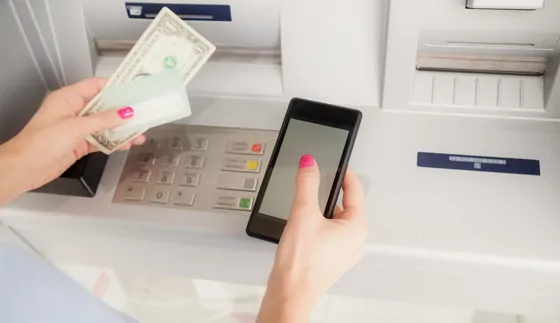Your Genesys Blog Subscription has been confirmed!
Please add genesys@email.genesys.com to your safe sender list to ensure you receive the weekly blog notifications.
Subscribe to our free newsletter and get blog updates in your inbox
Don't Show This Again.

Companies around the world, in all industries, are either considering, planning, or already executing digitalization processes or digital transformation strategies. Gartner defines this process as the use of digital technologies to change a business model, and “provide new revenue and value-producing opportunities.” It’s bigger than simply adding new customer interaction channels.
Digital technologies have been disrupting consumer behavior for many years. And now it’s changing customer engagement models and causing an imminent disruption in business models. We already see it in the reinvention of retail banking branch offices.
Transactions Shift from Branches to Digital
While digital transformation impacts all industries—banking, insurance, telecommunications—it has unique consequences in retail banking. The adoption of digital channels is driving the decline of branch visits, and as a result, bank branches. A report from analysts at Citigroup predicts that the number of bank branches could be cut in half over the next decade.
Fewer in-person visits reflects a fundamental shift in consumer behavior. We see it in e-signatures eliminating the need for in-person processing; simplification of offline payments; and social media purchases that use central communication hubs with context-driven interactions. These new customer engagement models are forcing the next stage of change—to business models—and banks look at the mission of their branch networks.
The Value of Low-Effort Customer Experience
The types of digital interactions noted above are now time-saving, seamless experiences for consumers, and each task takes very little effort. This has not been the case in traditional retail banking.
When the effort to engage with a branch is too high, it’s often the silos across digital, contact center, branches, and experts that’s at the root of the problem. And silos mean there’s no visibility into the end-to-end customer journey, and no context for each interaction. This old service model can’t meet today’s high customer expectations. Independent silos, whether processes, locations, or systems, reduce overall efficiency and makes it costlier to serve. Upsell opportunities are lost and an overall weak experience also impacts brand image. Considering the many new banking options available to consumers, higher rates of churn are an ongoing and serious risk.
Customer experience matters. It drives loyalty and revenue, and it lowers churn and associated costs. The key driver here is how much effort it takes a customer to complete a task. Reducing that effort can directly increase purchase behavior.
Achieving Full Digital Transformation
After several decades of changes, banks have achieved full digitalization of their banking processes for transactions and customer services. But this is only part of transformation. The old retail banking model—bricks and mortar banking with digital channels for transactions—will no longer work. Without change, banks risk being stuck with an expensive and inflexible distribution set-up.
And yet, customers still want personal contact for advice and sales. With in-person visits dropping, the role of branch staff in the customer journey is even more critical in creating trust and building relationships. Branches still have an important function, as more than 90% of customers open accounts there.
Combined with new technologies, banks can deliver the highest-quality customer service at a lower cost than before. But it’s dependent on building a low-effort digital experience with high-quality human touch—and lower cost to the branches. According to McKinsey & Company, digital transformation will equip banks with the new skills and ways of working that the competitive landscape increasingly demands.
Next Steps in Digital Transformation
Many banks are increasing the integration of digital within the physical branch, using mobile. For example, while customers are waiting in line they can connect to a virtual assistant or live chat agent, or have a customer service rep monitoring their social profiles to give those a customers personalized experience. This requires employees who can handle more complex, consultative interactions.
According to Kevin Steel in Banking Strategies, more banks are shifting toward “universal agents,” employees who can engage in sales of a range of services. While new service options gain traction, managers will need real-time visibility into customer demand to deploy staff for maximum impact.
Banks like Wells Fargo have moved to an omnichannel view of customers to break through the problems inherent with silos and gain visibility into the customer journey. This approach enables banks to build on available systems data and create a model of the business processes that reflect the customer’s true experience—not just their transactions—in interacting with the bank.
Similar to any other channel, to deliver an optimal customer experience the role of the physical branch needs to fit in a modern business model. But to do this cost-effectively, there will be more types of retail branches that offer services based on different missions. We see this in Accenture’s view of future branch models:

In the future, branch services will vary by their mission.
The Ongoing Journey of Digital Transformation
The mission of brick-and-mortar branches and their integration with digital channels is changing. One of the key data points from the 2016 Gartner CEO and Senior Business Executive Survey is that 84% of CEOs expect digital to increase profit margins. It can. But it requires Innovative technology that gives you visibility into the customer journey across all channels.
In Voices on Bank Transformation: Creating Lasting Change, Gerrit Zalm, Chairman of ABN AMRO advises, “…be customer-oriented with everything focused on sustaining long-term customer relationships.” In addition, technology will be increasingly important in building those relationships, and keeping them low-effort for customers.
Contact us today to learn more about the omnichannel banking experience and its role in digital transformations.
Subscribe to our free newsletter and get blog updates in your inbox.